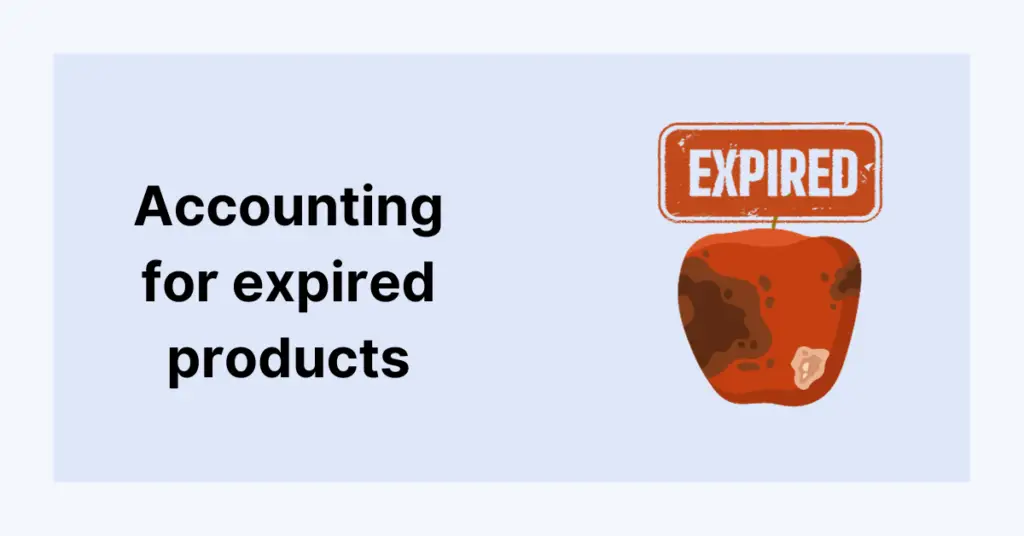In business, especially retail or manufacturing, it’s not uncommon for products to expire or become obsolete. Whether perishable goods like food and pharmaceuticals or tech products become outdated, having expired products in inventory is a predicament companies want to avoid but often must address. Accounting for expired products is an essential practice that ensures the accurate representation of a business’s financial health.
This comprehensive guide aims to delve into the details of accounting for expired products, offering practical advice and examples to ensure your company is both compliant and profitable.
What is Accounting for Expired Products?

Accounting for expired products refers to the systematic process of identifying and writing off goods in your inventory that have passed their useful life or expiry date. The procedure involves removing the expired items from your accounting books and taking appropriate actions such as disposal, donation, or liquidation. Proper accounting ensures that the financial statements reflect a more accurate valuation of your current assets and provide insights into inventory efficiency.
Why is it essential to account for expired inventory?
Accounting for expired products is critical for several reasons, each contributing to a company’s overall financial health and operational efficiency.
- Financial Accuracy: Accurate accounting ensures that the balance sheet reflects the true value of current assets. If expired goods are not accounted for, the inventory asset account could be inflated, leading to inaccurate financial reporting.
- Tax Implications: Expired products are typically written off as a loss, which can impact tax obligations. Proper accounting for these products enables businesses to take advantage of tax deductions related to inventory losses.
- Cost Management: Knowing the value of expired goods can help businesses identify inefficiencies in their inventory management or supply chain. This information can be leveraged to negotiate better terms with suppliers or to adjust ordering processes.
- Regulatory Compliance: Some industries, such as pharmaceuticals and food & beverages, have strict regulations concerning expired goods. Accurate accounting is essential for compliance and can help avoid fines or legal issues.
- Consumer Safety: In industries where expired products can pose health risks, accounting for expired inventory is not just a financial necessity but also a public safety requirement.
- Brand Reputation: Failure to account for and remove expired products can result in those products being sold, which could severely harm a company’s reputation and lead to loss of consumer trust.
- Decision Making: Data on expired products can offer insights into buying habits, seasonality, and product lifecycles. This valuable information can influence decision-making on procurement, marketing, and sales strategies.
How to record journal entries for expired products

Entering journal entries for expired products is a critical part of inventory accounting, allowing businesses to accurately reflect losses due to spoilage, expiration, or obsolescence. Here’s a simple example to illustrate how to make these journal entries:
For Example:
Imagine you own a grocery store, and you discover that $1,000 worth of dairy products have expired and must be disposed of.
Journal Entries
- Step 1: Write off the expired products to a loss account
To remove the value of the expired products from your inventory, you’ll debit an expense account called “Loss on Expired Inventory” and credit the “Inventory” account.
- Debit: Loss on Expired Inventory $1,000
- Credit: Inventory $1,000
This entry shows that you’ve incurred a loss of $1,000 due to expired inventory, and it also reduces your total inventory value by the same amount.
- Step 2: Account for disposal costs
If there are any costs associated with disposing of the expired products, such as waste disposal fees, you should account for them. Let’s say the disposal fee is $50.
- Debit: Waste Disposal Expense $50
- Credit: Cash or Bank $50
This entry accounts for the $50 cost to dispose of the expired products, reducing your cash or bank balance.
In this example, the first entry reflects the loss due to the expired products, and the second entry captures any additional costs incurred for disposing of them.
What are some industry-specific challenges in accounting for expired products, and how can they be addressed?

Different industries face unique challenges when accounting for expired products, mainly due to the nature of the goods involved, regulatory landscapes, and customer expectations. Here are some industry-specific challenges and how they can be addressed:
1. Pharmaceutical Industry
- Challenge: Expired drugs can have serious health implications, and the pharmaceutical industry is highly regulated. Failure to account for expired goods can lead to legal issues.
- Solution: Implement a real-time inventory management system with automated alerts for upcoming expirations. Make sure to segregate expired stock immediately and follow proper disposal methods.
2. Food & Beverage Industry
- Challenge: High Turnover Rates – Perishable goods expire quickly, making it difficult to keep track.
- Solution: Utilize batch tracking technology to monitor products based on their sell-by dates. Implement a first-expiry, first-out (FEFO) system to ensure the oldest items are sold or used first.
3. Fashion and Retail Industry
- Challenge: (Seasonal Inventory) Trends change rapidly, and last season’s inventory might not be saleable.
- Solution: Adopt dynamic pricing strategies to sell off inventory before it becomes obsolete. Keep an eye on sales trends to identify when to mark down items.
4. Automotive Industry
- Challenge: Vehicle parts may become obsolete as new models are released.
- Solution: Perform regular lifecycle analysis to understand when parts will likely become obsolete. Partner with suppliers to return or repurpose old stock.
5. Electronics Industry
- Challenge: Products can quickly become outdated due to fast-paced technological advancements.
- Solution: Adopt a just-in-time inventory system to keep minimal stock and reduce the risk of obsolescence.
6. Agriculture
- Challenge: Natural Factors such as weather conditions can cause crops to spoil.
- Solution: Use insurance to hedge against the loss due to natural factors and diversify crops to minimize risks.
By understanding the specific challenges faced in accounting for expired products in different industries, companies can adopt tailored strategies to address these issues effectively.
Summary
Managing inventory is a complex process beyond just stocking products and fulfilling orders. One of the overlooked yet crucial components is accounting for expired products. From making appropriate journal entries to leveraging technology, proper accounting practices ensure your business stays financially accurate and operationally efficient. Not only does this reflect the actual value of your assets, but it also keeps you in line with regulatory requirements and can offer tax benefits.
Related Content






